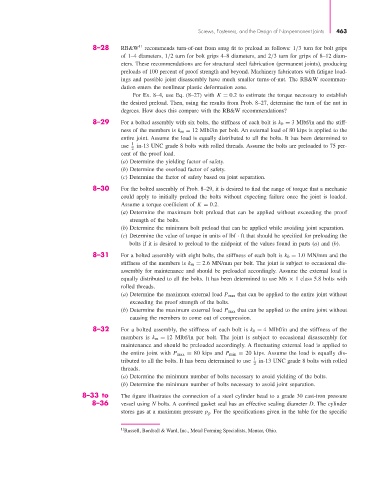Page 488 - Shigley's Mechanical Engineering Design
P. 488
bud29281_ch08_409-474.qxd 12/18/09 2:52 PM Page 463 epg Disk1:Desktop Folder:TEMPWORK:Don't-Delete Jobs:MHDQ196/Budynas:
Screws, Fasteners, and the Design of Nonpermanent Joints 463
8–28 RB&W 11 recommends turn-of-nut from snug fit to preload as follows: 1/3 turn for bolt grips
of 1–4 diameters, 1/2 turn for bolt grips 4–8 diameters, and 2/3 turn for grips of 8–12 diam-
eters. These recommendations are for structural steel fabrication (permanent joints), producing
preloads of 100 percent of proof strength and beyond. Machinery fabricators with fatigue load-
ings and possible joint disassembly have much smaller turns-of-nut. The RB&W recommen-
dation enters the nonlinear plastic deformation zone.
For Ex. 8–4, use Eq. (8–27) with K = 0.2 to estimate the torque necessary to establish
the desired preload. Then, using the results from Prob. 8–27, determine the turn of the nut in
degrees. How does this compare with the RB&W recommendations?
8–29 For a bolted assembly with six bolts, the stiffness of each bolt is k b = 3 Mlbf/in and the stiff-
ness of the members is k m = 12 Mlbf/in per bolt. An external load of 80 kips is applied to the
entire joint. Assume the load is equally distributed to all the bolts. It has been determined to
use 1 in-13 UNC grade 8 bolts with rolled threads. Assume the bolts are preloaded to 75 per-
2
cent of the proof load.
(a) Determine the yielding factor of safety.
(b) Determine the overload factor of safety.
(c) Determine the factor of safety based on joint separation.
8–30 For the bolted assembly of Prob. 8–29, it is desired to find the range of torque that a mechanic
could apply to initially preload the bolts without expecting failure once the joint is loaded.
Assume a torque coefficient of K = 0.2.
(a) Determine the maximum bolt preload that can be applied without exceeding the proof
strength of the bolts.
(b) Determine the minimum bolt preload that can be applied while avoiding joint separation.
(c) Determine the value of torque in units of lbf · ft that should be specified for preloading the
bolts if it is desired to preload to the midpoint of the values found in parts (a) and (b).
8–31 For a bolted assembly with eight bolts, the stiffness of each bolt is k b = 1.0 MN/mm and the
stiffness of the members is k m = 2.6 MN/mm per bolt. The joint is subject to occasional dis-
assembly for maintenance and should be preloaded accordingly. Assume the external load is
equally distributed to all the bolts. It has been determined to use M6 × 1 class 5.8 bolts with
rolled threads.
(a) Determine the maximum external load P max that can be applied to the entire joint without
exceeding the proof strength of the bolts.
(b) Determine the maximum external load P max that can be applied to the entire joint without
causing the members to come out of compression.
8–32 For a bolted assembly, the stiffness of each bolt is k b = 4 Mlbf/in and the stiffness of the
members is k m = 12 Mlbf/in per bolt. The joint is subject to occasional disassembly for
maintenance and should be preloaded accordingly. A fluctuating external load is applied to
the entire joint with P max = 80 kips and P min = 20 kips. Assume the load is equally dis-
tributed to all the bolts. It has been determined to use 1 in-13 UNC grade 8 bolts with rolled
2
threads.
(a) Determine the minimum number of bolts necessary to avoid yielding of the bolts.
(b) Determine the minimum number of bolts necessary to avoid joint separation.
8–33 to The figure illustrates the connection of a steel cylinder head to a grade 30 cast-iron pressure
8–36 vessel using N bolts. A confined gasket seal has an effective sealing diameter D. The cylinder
stores gas at a maximum pressure p g. For the specifications given in the table for the specific
11 Russell, Burdsall & Ward, Inc., Metal Forming Specialists, Mentor, Ohio.

